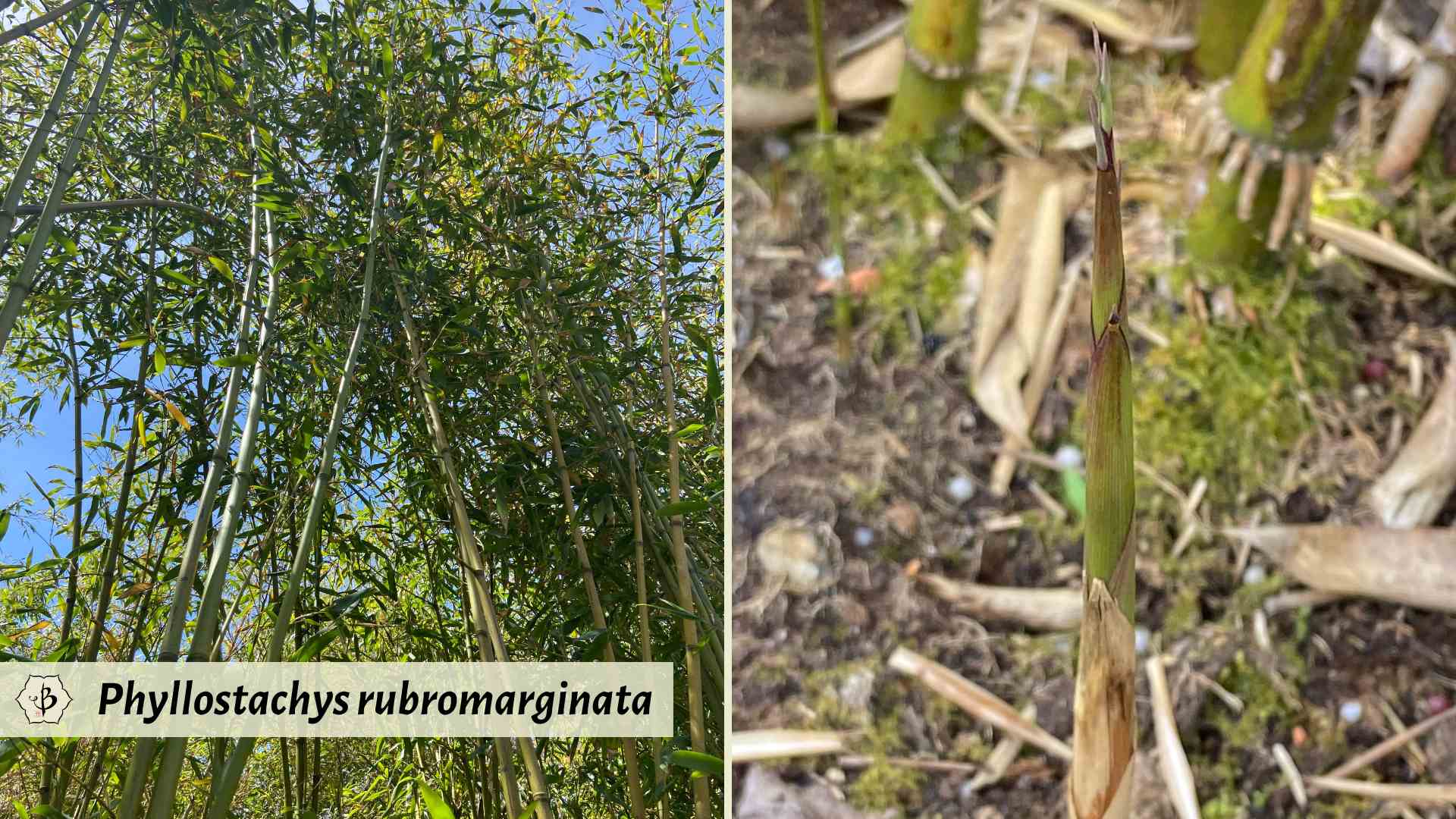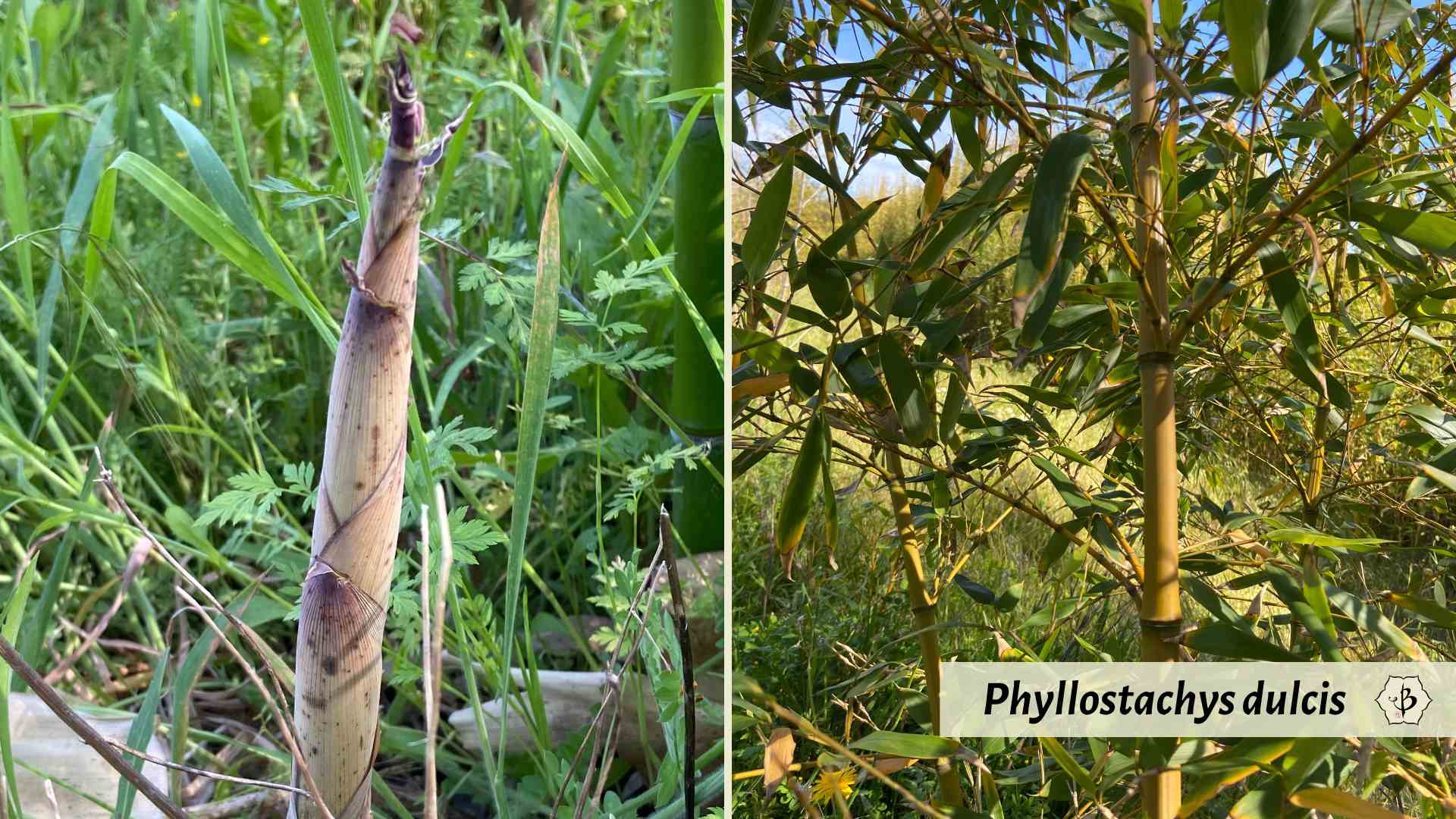If you’re worried about bamboo getting invasive and taking over your yard, you might want to steer clear of Phyllostachys rubromarginata. But if you want a thick privacy hedge, a fast-growing bamboo for a cold climate, or maybe a hardy species for a bamboo plantation, then Rubro, aka Red Margin Bamboo, could be the way to go.
Phyllostachys rubromarginata is a temperate running bamboo native to China. Its name translates to Red Margin Bamboo, based on the unusual coloration of its fresh shoots. This species is very popular both ornamentally and commercially because it is one of the fastest-growing varieties of bamboo and also extremely versatile. The shoots are edible, the culms (poles) are large and useful, and the plant can provide a tall and thick privacy screen. It also grows well in a wide variety of conditions, including freezing winters, wet soil, and full sun or dim shade.
NOTE: This article first appeared in April 2021, most recently updated in April 2024.
Characteristics of Phyllostachys rubromarginata
Growth habit
Like all species of Phyllostachys, Red Margin Bamboo is a runner. That means it has fast-spreading rhizomes that grow parallel to the ground and away from the main plant. As the root system establishes itself, it starts to put out shoots that grow upward, perpendicular to the running rhizomes. In botanical circles, we refer to these running rhizomes as monopodial or leptomorph, as opposed to clumping bamboo which we call sympodial or pachymorph.
In the first couple of years, the growth of a running bamboo may not be so noticeable, because most of the action is happening underground. But once it gets going, Red Margin can be among the most vigorous varieties of bamboo. As the old saying goes, “The first year it sleeps, the second year it creeps, and the third year it leaps.”
If your goal is to create a thick privacy screen, or to produce a preponderance of biomass for fuel or other purposes, then this aggressive growth rate will be a favorable characteristic. But if your garden space is limited, then you’ll definitely need to take precautions to contain this plant and its leaping rhizomes.

Size
Phyllostachys rubromarginata is not quite a timber bamboo, but it’s a good-sized specimen. In ideal conditions, or its native habitat, i.e. Central China, this flourishing grass can get to be 50 feet tall with culms as much as 3 inches in diameter. In more moderate North American climates, however, like USDA zone 6, it typically reaches 20-30 feet in height, with 1-2″ inch culms. And in cooler regions, like zone 5, it might only grow 12-15 feet.
Red Margin Bamboo definitely isn’t the biggest species of Phyllostachys. It’s no match for Moso or Henon, but it’s still bigger than most ornamental varieties. And it’s especially easy to cultivate.
Growing conditions
Phyllostachys is one of the more cold-hardy genera of bamboo. This makes them a popular choice of ornamental throughout much of Europe and North America, where bamboo is generally not native.
Most varieties of timber bamboo, such as Bambusa, Guadua and Dendrocalamus, are tropical plants. That means they probably won’t survive if the winters bring deep or prolonged freezing. In other words, you need a climate like Florida or Southern California. But Phyllostachys can be big, fast-growing, and extremely cold tolerant. P. rubromarginata is normally hardy down to about 5 or 10º below zero on the Fahrenheit scale.
Bamboo is generally not a very finicky plant. But some species, like Moso (Phyllostachys edulis) can be very difficult to get established. And many will grow a lot slower if the conditions are sub-optimal. Poorly drained soil or insufficient sunlight can impede the plant’s ability to thrive. But Red Margin Bamboo is nearly indestructible.
In sunlight or in shade, this variety can really flourish. Rubro also grows well in hard, clay soil, which its powerful rhizomes can help to loosen. Even in wet soil, which can often be a deal-breaker for bamboo, this species is surprisingly resilient.

Other features
In addition to its fast and furious growth habit, Red Margin Bamboo has a few other interesting characteristics. Not only can the culms spread quickly, outward and upward, but they also grow quite densely. The thick clumping of culms is what makes it a good choice as a privacy hedge.
Of course, the distinctive coloring on its young shoots, which earned this species its name, also adds interest to the plant. The edges or margins of the fresh culm sheaths have a red hue, visible in the image above.
Finally, Red Margin Bamboo is noteworthy for its long internodes. The smooth space between the nodes, or “knuckles”, often exceeds 12 inches, and sometimes stretches close to two feet on mature stalks. This can be a point of interest in the garden. But more importantly, it can be very desirable for certain crafts where long segments are needed, uninterrupted by nodal ridges.
Red Margin Bamboo as an ornamental variety
Because of its size and hardiness, this has become one of the most popular bamboo species among North American gardeners. Many people choose to plant bamboo because of its ability to spread quickly and thickly, to fill in a large space in a short amount of time. Rubro bamboo can definitely accomplish that. And based on those qualities, it can provide a dense and good-sized privacy hedge.
Moreover, it’s one of the most resilient species in this famously tenacious family of grasses. So for gardeners who are new to bamboo and not sure which species is best for their conditions, this is an easy choice. You can think of it as the People’s Choice of Bamboo.
At the same time, P. rubromarginata is the aggressive kind of species that has earned bamboo its notorious reputation as an invasive nuisance. Indeed, these vigorous roots can really overtake your yard. So if you have a smaller space or a sensitive flower bed, you’ll have to be very careful.
Check out our in-depth article on bamboo containment. You might also consider placing it in a pot or a container. Or avoid Red Margin altogether, and plant a cold-hardy clumping bamboo instead.
Phyllostachys rubromarginata for commercial cultivation
Based on the characteristics detailed above — its vitality, tenacity and resilience — Rubro has become a hot choice for farmers wanting to grow bamboo on their plantations. In the American Southeast, where the climate is generally warm and wet, this variety can truly thrive. It doesn’t need rich soil, and frosty winters are not a problem.
The poles of P. rubromarginata are not necessarily the most elegant and attractive. Although they do tend to be relatively large and straight, the culm walls are not especially thick, and they can be susceptible to cracking. So these are not the best choice for building or construction.
But if you’re just trying to generate biomass, then Rubro bamboo is ideal. This is a dense grower, and you’ll have a hard time getting more bamboo per acre than with this species. In that case, it’s an excellent choice to grow for making bamboo ethanol or bamboo paper. These applications don’t require premium quality poles, but simply the greatest quantity of biomass.
A well-established grove of Red Margin Bamboo can also produce a profusion of fresh shoots. Not every species has edible shoots, but this variety is known to be very tasty. You can pickle the shoots to make something similar to sauerkraut, or you can boil and dice them to add to stir fry or other Asian dishes. For bamboo farmers, the edible shoots offer one more way to cash in on their crop.
Like any bamboo farming, one of the chief benefits is bamboo’s ability to replenish. As the culms are cut down, the rhizomes endure, so there’s no need to start new plants. Not only that, but unlike trees, the bamboo root systems continue to store their carbon even after the harvest. Economically and ecologically, it just makes sense.
Learn more
If you enjoyed reading about Phyllostachys rubromarginata, you may want to check out some of these other popular resources and articles on bamboo cultivation.
- A directory of bamboo nurseries
- Growing bamboo: A how-to guide
- Bamboo farming in the US
- Running bamboo: Why must you run?
FEATURE IMAGE: Tall row of Phyllostachys rubromarginata growing at Bambu Parque, Portugal. Photo by Fred Hornaday.

























